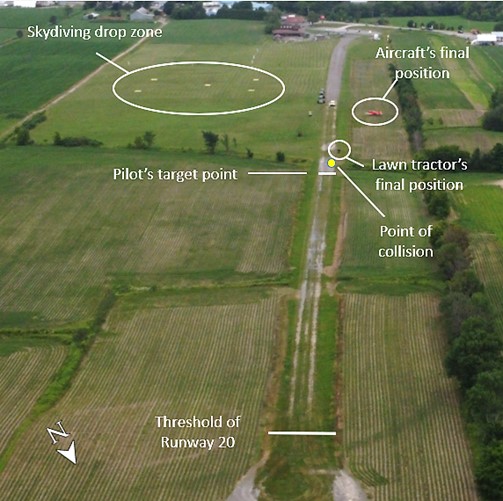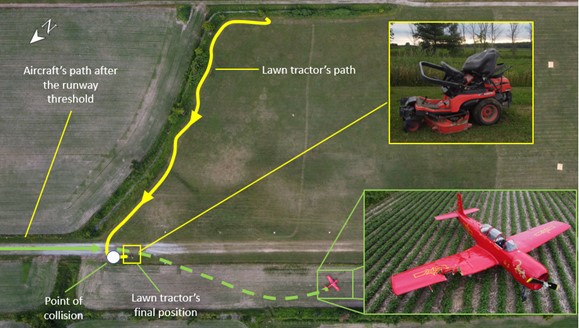Collision with a lawn tractor during landing
Nanchang CJ6A
Saint-Esprit, Quebec
The Transportation Safety Board of Canada (TSB) investigated this occurrence for the purpose of advancing transportation safety. It is not the function of the Board to assign fault or determine civil or criminal liability. This report is not created for use in the context of legal, disciplinary or other proceedings. See Ownership and use of content. Masculine pronouns and position titles may be used to signify all genders to comply with the Canadian Transportation Accident Investigation and Safety Board Act (S.C. 1989, c. 3).
History of the flight
At approximately 1130Footnote 1 on 05 July 2021, the privately registered single-engine Nanchang CJ6A aircraft (registration C-GYAC, serial number 1232028) took off for a local visual flight rules (VFR) flight from Joliette Aerodrome (CSG3), Quebec, to St-Esprit Aerodrome (CES2), Quebec. The pilot, who was the sole occupant, intended to conduct 2 aerobatic training flights: 1 in the morning and 1 in the afternoon after having lunch at CES2. CES2 is a private aerodrome leased and operated by Parachute Montréal, a parachuting club for which the occurrence pilot occasionally worked as a pilot. During the flight, the pilot attempted, unsuccessfully, to communicate with the club’s skydiving aircraft (a DHC-6 Twin Otter aircraft, registration N301CL) to find out whether any jumps were in progress. Once he was close to the aerodrome, he circled several times to check. Having spotted some skydivers but not the Twin Otter either in the air or on the ground, he attempted once again to contact the Twin Otter to obtain its position and succeeded in establishing communication. The pilot of the Twin Otter confirmed that jumps were in progress and that he was on final approach for Runway 20. The 2 pilots agreed to land one after the other, with 1 minute of separation between them, and decided that the Twin Otter would land first.
After the Twin Otter had landed, the pilot of the Nanchang, who did not see any traffic in the circuit or on the ground, joined the left base leg of the circuit at an altitude of approximately 500 feet above ground level (AGL) before turning onto final at approximately 300 feet AGL. Because the surface of the grass strip runway was in poor condition at the threshold and beyond, the pilot chose a target point approximately 800 feet beyond the threshold and began to flare approximately 300 feet before the target point (Figure 1). At about the same time, a lawn tractor that was performing maintenance work at the aerodrome crossed Runway 20 near the pilot’s intended target point and began a turn to the left to cut the grass parallel to the runway.
During the flare phase, with the aircraft in a normal configuration for landing, the pilot could no longer see the runway ahead of him and looked to the right to assess the aircraft’s height. At the moment when he expected to reach the touchdown point, he heard a noise and immediately felt the aircraft deviate to the right. He was able to stop the aircraft on the right side of the runway strip.
Seeing damage to the right wing, the pilot realized that he had struck something. He exited the aircraft and saw the lawn tractor to the right of the runway not very far from the touchdown point. The aircraft had struck the tractor, and the driver was fatally injured. The pilot was not injured. There was major damage to the aircraft’s right wing (Figure 2).
Meteorological information
According to the aerodrome routine meteorological report (METAR) issued at 1100 for the Montréal International (Mirabel) Airport (CYMX), Quebec, located 20 nautical miles (NM) southwest of the accident site, weather conditions were favourable for this VFR flight and were not considered to be a contributing factor in this accident.
Pilot information
The pilot held the appropriate licence and ratings for the occurrence flight in accordance with existing regulations: he held a valid Canadian airline transport pilot licence — aeroplane and Category 1 medical certificate, both of which were valid. He had a Class 3 flight instructor rating – aeroplane and a Group 1 instrument rating. At the time of the accident, the pilot had accumulated more than 1300 hours on the Nanchang. He knew CES2 because he occasionally flew the club’s Twin Otter for skydiving jumps and flew there from time to time with his Nanchang.
According to information gathered during the investigation, there was no indication that the pilot’s performance was affected by medical, pathological, or physiological factors.
Aircraft information
The Nanchang CJ6A is a demilitarized single-engine aircraft designed and built in China. The occurrence aircraft had been issued a special airworthiness certificate by Transport Canada on 01 June 2006 and had no known deficiencies before the occurrence. Because of the aircraft’s configuration (long nose, radial engine, and pilot position), the pilot temporarily loses visibility in front of the aircraft when beginning the flare.
Aerodrome information
CES2 is a private aerodrome that is leased and operated by Parachute Montréal and is used exclusively for skydiving activities. It has a single grass strip (Runway 02/20). As an aerodrome, CES2 is governed by Subpart 301 of the Canadian Aviation Regulations (CARs), which is much less restrictive than Subpart 302, which applies to airports.Footnote 2 CES2 is listed as registered in the Canada Flight Supplement and is annotated with prior permission required (PPR), which means that, at all times, “the aerodrome owner’s or operator’s permission is required prior to use, except in cases of emergency.”Footnote 3 Given that the occurrence pilot occasionally did work for the skydiving club at this aerodrome, he believed that he could fly there without a PPR, and he had therefore not notified the operator of his intentions before the flight.
Summer maintenance of the aerodrome
Skydiving activities at CES2, which begin in March and end in November, require that the grass be cut in manoeuvring areas and in the drop zone.
The aerodrome manager uses a subcontractor, the same one since 2017, for this purpose. CES2 does not have written procedures for maintenance of the aerodrome, nor are such procedures required by the CARs. However, according to a verbal agreement between the aerodrome manager and the subcontractor, the grass is to be cut only when the Twin Otter is on the ground at CES2 and no skydivers are in the air, given that the drop zone is adjacent to the manoeuvring areas (Figure 1).
According to the verbal agreement, the subcontractor decides when the grass will be cut and does not have to notify the aerodrome manager in advance or coordinate its activity with the manager. On the day of the occurrence, no coordination had taken place between the subcontractor and the aerodrome operator.
The investigation revealed that the grass cutting team, which generally consisted of 1 to 3 people, tended to cut the grass at CES2 early in the morning, before skydiving jumps began. On the day of the occurrence, the usual team was unavailable. Instead, another person was cutting the grass, alone. She was not employed by the subcontractor but was performing the task to assist the subcontractor, as she had recently done a few times.
The investigation was unable to determine whether the tractor driver was aware of the presence of the Nanchang.
She was not wearing a safety vest or head protection, and was not using a radio.
Safety message
This accident highlights how important it is for pilots to obtain permission to use an aerodrome when prior permission is required, so that aerodrome operators can coordinate the various activities taking place at the aerodrome, to ensure that the activities are carried out safely.
In addition, individuals working near a runway must remain vigilant and continually scan the runway and its 2 approaches before entering or crossing it.
This report concludes the Transportation Safety Board of Canada’s investigation into this occurrence. The Board authorized the release of this report on It was officially released on

